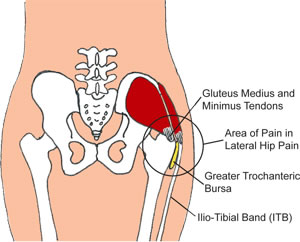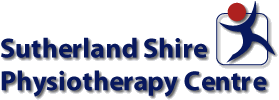|
|
 |
|
| |
Lateral Hip Pain
(Pain at the side of your hip and thigh - once called "Bursitis" ) |
Lateral hip pain is a condition where you have pain on the outer side of your hip that can run down the side of your thigh to your knee. It is often at its worst when lying in bed at night or when sitting for long periods, especially in a car or other low seat. It is more common in women than men, especially in the 40 - 60 age group, but can also occur as an over-use injury in young people, especially runners and other athletes. (1) It is also common in the second half of pregnancy.
|
What causes lateral hip pain?
Research has shown that the pain is most likely due to irritation, degeneration or tearing of one or two of the smaller hip muscle tendons (gluteus medius and minimus) where they attach into the hip bone. (2) You may have been given the diagnosis of bursitis. However, the research shows that swelling of the bursa on the side of the hip (the greater trochanteric bursa) only occurs in around 10% of people with lateral hip pain. (3,4) The cause of the tendon damage is usually compression, due to tightness of the large hip muscle tendons, especially the ITB (see diagram on right) or over-activity of the larger hip muscles pushing on the underlying smaller tendons.
Certain activities will cause this over-activity or tightness, such as standing for long periods with one hip pushed out to the side, poor posture in sitting or standing, crossing your legs when you sit and sleeping on your side with your knees bent up to right angles. The pain can be related to walking or running on surfaces that slope sideways such as a beach or always running the same direction around a track. Inappropriate or worn out footware can also be a problem. |
 |
 |
| |
 |
| |
 |
| |
Lateral hip pain can be caused by tight or
over-active muscles causing compression
to the structures at the side of the hip. |
| |
|
|
|
Treatment
Your physiotherapist will take a detailed history of your condition and carefully examine your symptoms to ascertain which structures and what activities are causing your pain, where you are tight and where you are weak. Your treatment programme will be specific to your particular symptoms, but may include massage to release tight structures, joint mobilisation, posture correction, stretches and exercises to improve strength, balance and core control and advice to help you modify any of your daily activities that are aggravating your condition.
Recovery
Lateral hip pain recovers very well with treatment, but recovery can be slow. If your symptoms are mild and you have not had the pain for long, recovery may only take a few weeks. If you have had your pain for months or longer, you will begin to see improvement with treatment and your home programme within a few weeks, but full recovery can take longer.
Self Help
- Avoid sitting with your legs or feet crossed.
- Avoid sitting with your feet wide apart and your knees together.
- Avoid sitting with your knees wide apart, your thighs should be parallel.
- Avoid low or saggy chairs. A wedge cushion may make sitting more comfortable.
- When lying in bed try sleeping on your back with a pillow under your knees or on your side with a pillow or two between your knees to keep your thighs parallel.
- When standing, don’t stand with your hip pushed out to one side.
- If you walk or run, avoid running around a track always in the same direction and avoid running on a beach or road where there is a camber (ie a sideways slope).
- Avoid stretches that bring your knee across your body as these cause more compression on the injured tendons and bursa.
- The best way to ease the pain when it starts is to move. However, if you are sitting somewhere where you can't get up immediately such as on a long drive, sitting at lunch or the movies or lying in bed, you can try squeezing your buttock muscles firmly for 10 seconds then relaxing slowly. This will sometimes help to relieve the pain in your hip for a little while.
- If you have to stand for long hours shift your weight from foot to foot or try putting one foot up on a small stool. Avoid standing with your hip pushed out to one side.
- If you work at a desk, get up and move around every 20 minutes or so. (See our Computer Posture page for more information on good posture and work station set-up.)
At Sutherland Shire Physiotherapy Centre we have many years experience in the treatment of musculo-skeletal injuries. Call today to schedule an appointment with one of our physiotherapists.
Last updated: 1st August, 2020
Please note that the above information is of a general nature and is not intended to substitute for professional advice. You should always seek the advice of your qualified health practitioner to attain a proper diagnosis before starting any treatment regime.
References
- Grimaldi A, Lateral hip pain: mechanisms and management, In Touch, 4: 16-19, 2010
- Woodley SJ, Nicholson HD, Livingstone V, Doyle TC, Meikle GR, Macintosh JE, Mercer SR, Lateral hip pain: findings from magnetic resonance imaging and clinical examination: Journal Orthopaedic Sports Physical Therapy: 38(6):313-28: 2008
- Connell DA, Bass C, Sykes CA, Young D, Edwards E. Sonographic evaluation of gluteus medius and minimus tendinopathy. Eur Radiology: 13:1339-47: 2003
- Byrd JWT, Jones KS, Hip arthroscopy in athletes, Clinical Sports Medicine: 20: 749-62: 2001
- Grimaldi A, Richardson C,Stanto W, Durbridge G, Donnelley W, Hides J, The association between degenerative hip joint pathology and size of the gluteus medius, gluteus minimus and piriformis muscles. Manual Therapy: 14: 605-10: 2009
- Hamilton N, The irritable hip, Course Manual, 2010
- Wajswelner H, Gluteal Tendinopathy: A Long-Term Focus, In Motion, APA, April 2014
[Return to Top] |
|
|
|
